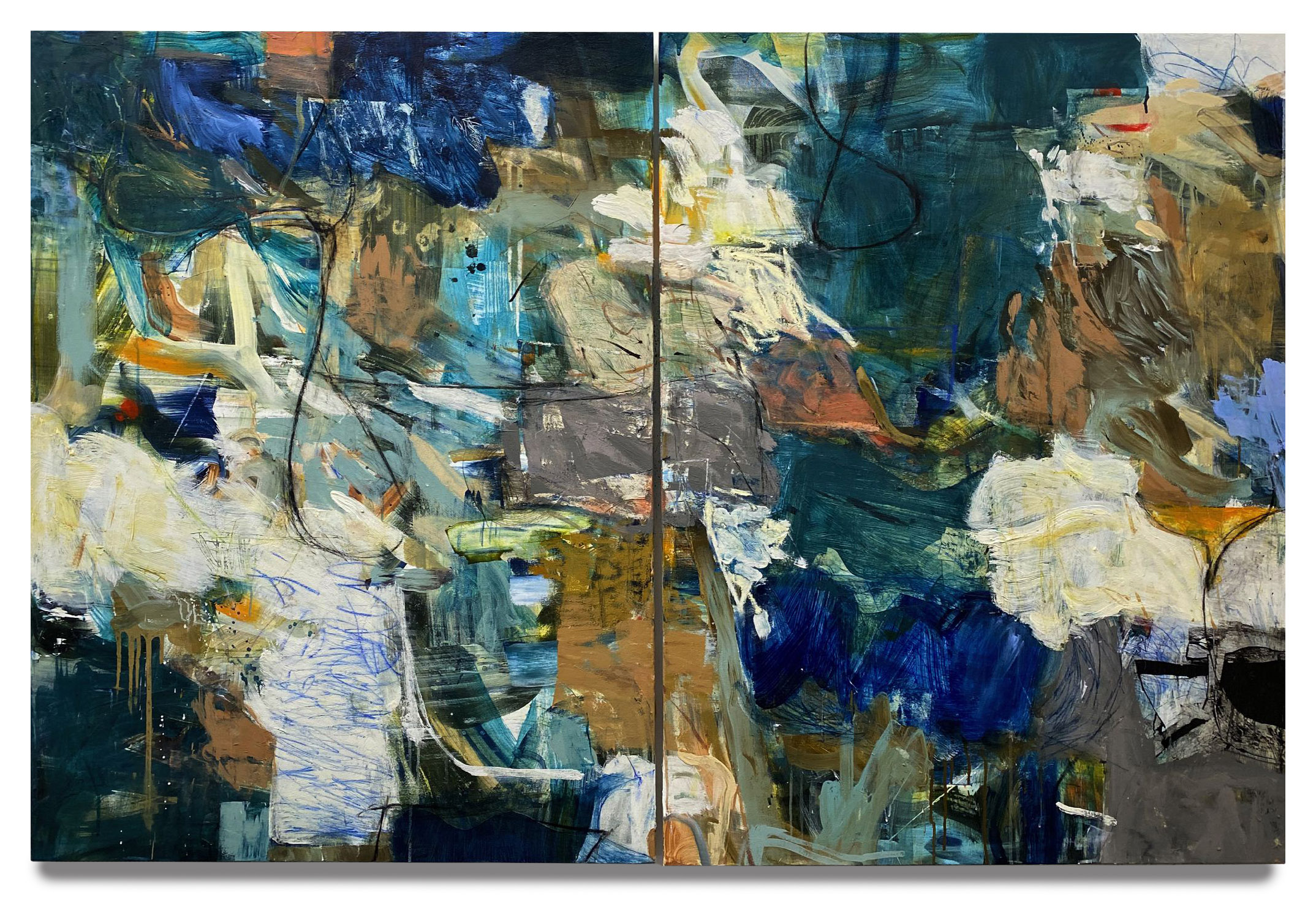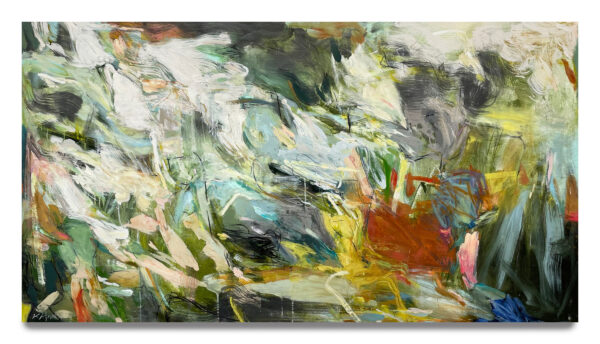
31 Jan Telluride Gallery: “No Reason, No Rhyme”+ Reafsnyder “Selected Works,” through 2/27!
The Telluride Gallery of Fine Art is pleased to present “No Reason, No Rhyme,” an exhibition featuring two gallery artists: Kristin Beinner James and Krista Harris + Michael Reafsnyder “Selected Works,” his first solo show at the Gallery. The exhibitions are on view starting with Telluride’s Arts’ Art Walk Thursday, February 3, 2022, 5 – 8pm. The show will remain up through Sunday, February 27.
Go here to find more about Telluride Gallery.
Go here to learn more about other participating Art Walk galleries.

Image, Krista H

Image, Kristin Beinner James
Three artists.
Two shows.
One ethos: The art of Kristin Beinner James, Krista Harris and Michael Reafsnyder breathe the same friendly air of abstract art adventures, eye-dazzling gifts to the vision and imagination.
Front room: “No Reason, No Rhyme”
Beinner James and Harris are featured in “No Reason, No Rhyme,” which takes its name from two new works on pager by Harris. Both women began as representational artists, but wound up taking a sharp left turn on their path.

“I’ll place the shift from landscapes to abstractions to somewhere in La Grave, France, in 1999,” explained Beinner James. “I was skiing with someone, then, at some point, I was alone in a white-out, not sure which way to go. There was only one boundary marker visible, some slightly buried mesh fencing. I could not ascertain which side of this fence was the way to go down or whether I was in bounds or out. I still address this moment in my painting. So, there’s a continuum, from depicting landscapes to modeling perception in space. Painting for me isn’t so much a picture of something, rather, painting is an inquiry, a filter, an open space to fill and explore.”
“In my experience, Abstract Expressionism or ‘Action Painting’ influenced nearly all forms of painting today. We stand on the shoulders of that loose confederation of artists and pay homage to the freedom to paint from an internal source rather than a solely exterior inspiration,” said Harris. “That movement certainly directed my path – though that came as a huge surprise. I wasn’t drawn to abstraction until much later in my life, when I became frustrated and dissatisfied with the representational work I had been producing for years. Came he internal inquiry:‘How can I push myself and my work to its limits, how can I make my best work, what does that look like?’ It felt like a huge risk, but wasn’t optional. Abstract art was clearly the way forward for me.”

Beinner James is a climber and explains the non-objective art that followed her landscapes as follows:
“Figuring out a route in bouldering is referred to as a ‘problem.’ I think of painting and bouldering as good problems. Both involve route-finding. In both activities, one physically grapples with material, with your hands. They are alike in that both are generative and have to do with touch.
“I read that a climber should climb with her eyes first. It seemed a useful way to prepare and quell fears of the unknown. I painted what I saw to understand it. After my ‘white out’ moment in France, when I couldn’t see very much, I wondered how I could locate myself in space. I wondered if I could grasp vision. What if I projected a sense of touch on vision, could I see by feel? I translated this experience to my painting practice now.”
To create her images, Beinner James employs various tools and speeds of application to render an indexical topography of paint on the front of the painting. A shadow and a record of the action of the back is visible through the front.
“I paint with acrylic or oil, mixed with wax, to give the paint body. I extrude this mixture through the back of a stretched support- linen or other surfaces- so that the paint seems to suspend or transgress the picture plane. I’m interested in the language and space of painting, of making painted marks that could read like visual braille or a topographical map.
‘“Straddling the support from the side, I paint by feel, at times unable to see the resulting image as it emerges. In an auto-poetic response, my painting is complete when the ground is saturated and resists further applications of paint. My aim is for these paintings to hover in-between intention and result, front and back, near and far, inside and outside. Each work presents an other-side, a space of porous boundaries.”
Defining the role of color in her art, Beinner James says:
“Color has so much presence yet it is elusive. I’m curious about certain colors. I wonder about orange. Do I see the orange of an orange as someone else does? Certain colors for me seem to hover like yellow. Some seem harder to locate like blue. I use colors like white, yellow, and orange because they seem hard to contain, hard to hold. Also, I use color to disrupt other colors.”
Beinner James received her MFA from the Art Center College of Design in Pasadena, CA, and has been exhibiting her work since 1989.
“I was the only artist in my immediate family. I don’t think I ever decided to be a professional artist. That just happened.”
For Harris the process of mark-making begins with what she describes as “visual eavesdropping.”
“‘Visual eavesdropping’ is a term I use to describe the process of being in a state of slow looking, when I become acutely focused and firing all my senses – not just sight, but sounds, smells, tastes, memories, dreams. Anything becomes fuel and inspiration for my paintings. Employing elements of gravity and chance that will help me share a personal experience or an internal narrative through a non-objective process so that it connects with the viewer in a visceral way.”

The discipline that follows does not take one particular path. It is more driven by what the artist is mentally or visually exorcising and/or hoping to convey:
“I will sometimes start on the floor, pouring paint and various mediums, other times I am working on the wall with line and mark. Different approaches create different energy and direct the work in a slightly different direction, which keeps the canvas open to new possibilities. It’s basically a balancing act of the beautiful, awkward, messy, obsessive, and exhilarating.”
The resulting paintings feel at once wide open and elusive. Influenced as Harris stated above by the post-WWII Abstract Expressionists, her new work shows “richly layered and nuanced surfaces that keep various ideas up in the air” just waiting to land. That sleight of hand, that expectation, lures viewers into rethinking what they see in front of them, much as the artist does throughout her creative process.
Harris has been exhibiting nationally since the early 2000s. Her work is included in both corporate and public collections worldwide. This will be her 8th exhibition at the Telluride Gallery of Fine Art since 2013.
“As far back as I can remember I have felt like an artist. My family supported and encouraged me so I was validated early on and pursued every opportunity to take classes. I majored in Painting and Printmaking at East Carolina University and always aspired to being a professional painter, though I didn’t have a clue how to go about that or what it even looked like! It wasn’t until I turned 50 that I took that leap to pursue painting full-time.”
A common belief among historians in the art world is that artists, from objective to non-objective, always wind up painting themselves.

“I think of my paintings more as my offspring than myself. They come from me, I made them, but they operate and exist outside of my control. However, my paintings do seem most like me when they reveal, conceal, withhold, trace, hint at, filter, track, point to, suspend, hover or hide,” explained Bienner James.
“Absolutely right. What else is there? The expression ‘write about what you know’ is doubly true of artists. We are the filters for all that is around us,” answered Harris.
Back room: Michael Reafsnyder, “Selected Works”
Michael Reafsnyder’s abstractions convey a sense of delirious happiness. Although they look like the product of spontaneous gestural painting, his works are, in fact, carefully crafted to convey frenetic energy, each brushstroke, thick swath of acrylic, or vibrant color deftly deployed in the creation of an overall sense of manic exuberance and a love of life.

Conjuring, tongue planted firmly in cheek, the “action painting” of traditional Abstract Expressionism, Reafsnyder’s bright canvases are more playfully sarcastic and confrontational than muscular and testosterone-laden. The artist uses super thick layers of acrylic paint on canvas, arming himself with plastic blades to create deep, saturated abstract pieces that are laboriously well thought out and carefully composed.
“My paintings are acrylic on stretched and primed linen, the paint manipulated with a plastic blade (never a brush), recording a layered narrative in candy-like swirls. Completing a painting in a single sitting allows risk to enter into the process. Things can go wrong quickly, but, when all comes together, they can take on a palpable energy and immediacy in the completed work, an energy and immediacy that is impossible to achieve otherwise. The balance between playful exuberance and knowing combine to make paintings that allow viewers room to roam. AbEx or Action Painting certainly influenced my thinking about making art. But, I see joy and not angst in the work. I see images that are vital, alive, complex, and life-affirming. Perhaps I am naive in this regard.”
Naive?
Critics disagree:
“Reafsnyder’s works couldn’t be more contemporary. Comprised almost entirely of aggressive smears of screaming yellow, electric blue, fire engine red, and pure white paint squeezed straight from the tube, these whiplash images make Impressionism’s rapidly dabbed surfaces look like fussy Old Master compositions. Jazzed up by an occasional skid of purple or black, they also recall Willem de Kooning’s classic canvases, whose furious surfaces look as if they’ve been chiseled or carved in some kind of transformative frenzy. For viewers, this simply means that Reafsnyder’s art is a pleasure—even a joy—to behold. After all, it causes you to smile, and then returns the favor by smiling right back at you,” wrote critic David Pagel.
Reafsnyder casually mentions from time to time that he often feels inspired by one particular Renoir quote: “Only the painter who knows his business can create the impression that a picture was done in one stroke.”
“I happen to believe that (Michael) isn’t only inspired by these words; he is also their contemporary embodiment,” said artist Maria Brito, an award-winning New York-based contemporary art advisor, author, and curator.

Born in Southern California in 1969, Reafsnyder received his MFA from Art Center College of Design, Pasadena in 1996.
“While in undergraduate studies, I had the privilege of working with a professor, Bill Boaz, who had studied with Hans Hofmann. On the first day of class, I was introduced to the work of Cy Twombly and I knew then that my life would be centered on painting.”
Reafsnyder’s paintings have been the subject of numerous solo exhibitions at such venues as Miles McEnery Gallery, New York; Susanne Vielmetter, Los Angeles; Galeria Marta Cervera, Madrid; Uplands Gallery, Melbourne; Blum and Poe, Los Angeles; and the Las Vegas Art Museum.
His art is housed in numerous collections too, including the Los Angeles County Museum of Art; Museum of Contemporary Art, San Diego, CA; Columbus Museum of Art, Ohio; Las Vegas Art Museum; North Dakota Museum of Art; Progressive Corporation; Harvard University; Portland Museum of Art; and the Weisman Museum of Art, Los Angeles, California, among other venues.
With its first solo exhibition of Michael Reafsnyder’s work, the Telluride Gallery invites viewers to experience painting at its freest and most sophisticated, each gesture and color suggesting a complex and rewarding space for contemplation.


Sorry, the comment form is closed at this time.